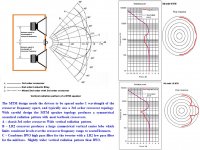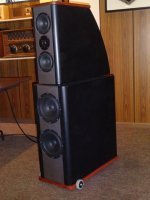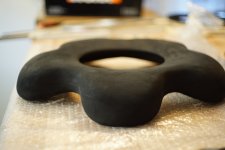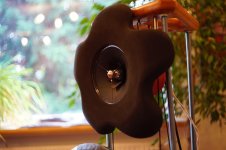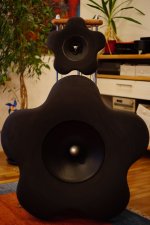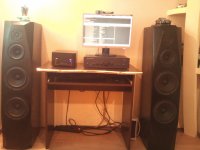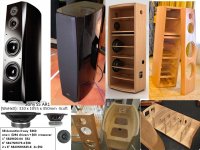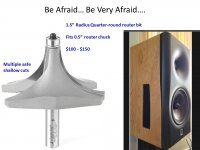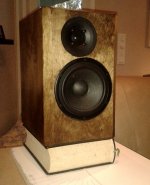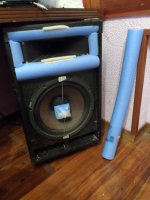I'm considering (very early stages) of building an dual purpose MTM speaker (for music and home theater) and I'm very much drawn to the aesthetics of curved enclosures done by transverse laminated birch plywood. I'm imagining something similar to this design but without any of the metal: Cross-post from r/DIY-- I built some really nice speakers : diysound
There are TONS more well established MTM designs out there for standard rectangular enclosures than for curved ones (in fact I can't really find a single documented curved design MTM that's been built more than once... someone please link a design if you know of one!) Can I borrow a design using a rectangular enclosure and build it using a curved enclosure so long as I keep the same internal volume? Will the curvature itself and the intentional narrowing near the back effect the sound or response in any way?
There are TONS more well established MTM designs out there for standard rectangular enclosures than for curved ones (in fact I can't really find a single documented curved design MTM that's been built more than once... someone please link a design if you know of one!) Can I borrow a design using a rectangular enclosure and build it using a curved enclosure so long as I keep the same internal volume? Will the curvature itself and the intentional narrowing near the back effect the sound or response in any way?
The curved surface will reduce diffraction, which could affect voicing.
The curved surface could also change the baffle step frequency, depending on the shape.
IMHO, it's a different speaker.
It may have the potential to be a better speaker, but you will need to voice it.
The curved surface could also change the baffle step frequency, depending on the shape.
IMHO, it's a different speaker.
It may have the potential to be a better speaker, but you will need to voice it.
Likely some acoustical changes. Some simple, like changing (spreading out = good?) the interior resonances. But mainly, I imagine it shows off your woodworking skill 😀
I have done exactly what you are proposing with excellent results.
The key is to keep the cabinet width and height and the driver positions on the front baffle as close as possible to the original. No more than a 10% deviation will keep any baffle diffraction changes to a minimum. Adding the large radius curves to the front probably means that the width must be increased so that's the one you need to watch out for. And given the change from rectangular to curved sides probably also means that you will need to increase the depth to maintain the same original internal volume. Not a problem to change that one. In fact a curved internal inverted horn type of shape offers a couple of design benefits - less internal standing waves and better attenuation of the rear sound energy.
The key is to keep the cabinet width and height and the driver positions on the front baffle as close as possible to the original. No more than a 10% deviation will keep any baffle diffraction changes to a minimum. Adding the large radius curves to the front probably means that the width must be increased so that's the one you need to watch out for. And given the change from rectangular to curved sides probably also means that you will need to increase the depth to maintain the same original internal volume. Not a problem to change that one. In fact a curved internal inverted horn type of shape offers a couple of design benefits - less internal standing waves and better attenuation of the rear sound energy.
1) A cabinet of the spec volume with curved sides and rear can modestly reduce resonance effects. A standard rectangular cabinet with a "V-shaped" internal brace behind the midwoofers, plus rear absorption material, can be more effective at resonance reduction.
2) One example of MTM with large radius edge rounds on the front baffle to reduce distortion.
Audio Society of Minnesota
SB Acoustics Reference Speakers
SB Acoustics Reference Speakers - Audio Society of Minnesota
3) The MTM topology produces a center lobe radiation pattern which favors seated couch listeners.
4) Would a floor standing TMW 3-way fit your room plans? More uniform radiation pattern. Cleaner midrange. Real stereo bass.
2) One example of MTM with large radius edge rounds on the front baffle to reduce distortion.
Audio Society of Minnesota
SB Acoustics Reference Speakers
SB Acoustics Reference Speakers - Audio Society of Minnesota
3) The MTM topology produces a center lobe radiation pattern which favors seated couch listeners.
4) Would a floor standing TMW 3-way fit your room plans? More uniform radiation pattern. Cleaner midrange. Real stereo bass.
Attachments
Hi Scone,
you´ve asked about the sonic improvements, and I might add my experience along the way with my speakers, although of a quite different conception.
I found that minimising diffraction (and in the same way, minimising baffle effects in my dipole OB system) will lead to
- a more precise system with less "hash" will give you a better insight and a clearer view onto the music (sorry if I sound not precise, English is not my mother language). This can actually distract your musical joy, as you´ll hear more of the problems inherent in either recording and design... but if all else is right, a good thing in my book.
- a better localisation of instruments in 3-D space, given all else is right.
- less listening fatigue, given all else is right.
So, if you´re able to invest time and money in diffraction control, this is a good thing in my opinion. For all technical matters and a lot more input there are several threads here on this forum, like this one
Baffle Diffraction
It all depends on how much efforts you´re willing to invest - for cheap systems there´s a barrier somewhere - but it will pay out in the end.
All the best
Mattes
you´ve asked about the sonic improvements, and I might add my experience along the way with my speakers, although of a quite different conception.
I found that minimising diffraction (and in the same way, minimising baffle effects in my dipole OB system) will lead to
- a more precise system with less "hash" will give you a better insight and a clearer view onto the music (sorry if I sound not precise, English is not my mother language). This can actually distract your musical joy, as you´ll hear more of the problems inherent in either recording and design... but if all else is right, a good thing in my book.
- a better localisation of instruments in 3-D space, given all else is right.
- less listening fatigue, given all else is right.
So, if you´re able to invest time and money in diffraction control, this is a good thing in my opinion. For all technical matters and a lot more input there are several threads here on this forum, like this one
Baffle Diffraction
It all depends on how much efforts you´re willing to invest - for cheap systems there´s a barrier somewhere - but it will pay out in the end.
All the best
Mattes
Attachments
Thanks for the answers all, this is very helpful. I don't anticipate wanting to change the shape (or amount of rounding) of the baffle, so I guess I shouldn't see too many differences? I have to clarify that this is 100% for visual aesthetics, I'm not hoping to improve upon any speaker designs, I just don't want to audibly detract from them either.
As far as changing the voicing, will this be something that can I address after the cabinet is built by tweaking the components in the cross-over? I just don't want to build myself into a hole after having spent $100s on components and many hours on a cabinet only to discover there's no way to make it sound good.
As far as changing the voicing, will this be something that can I address after the cabinet is built by tweaking the components in the cross-over? I just don't want to build myself into a hole after having spent $100s on components and many hours on a cabinet only to discover there's no way to make it sound good.
2) One example of MTM with large radius edge rounds on the front baffle to reduce distortion.
Audio Society of Minnesota
SB Acoustics Reference Speakers
SB Acoustics Reference Speakers - Audio Society of Minnesota
Yeah this is one of things I learned *after* building my first set of speakers (also an MTM) way back in 2004. I'm still listening to them and still enjoy them but I would definitely round the baffles a LOT more next time.
3) The MTM topology produces a center lobe radiation pattern which favors seated couch listeners.
4) Would a floor standing TMW 3-way fit your room plans? More uniform radiation pattern. Cleaner midrange. Real stereo bass.
I don't mind that it favors couch listeners. That's precisely where I'll be sitting when I listen to them. 😀
One thing to watch out for - a thin baffle with a curved back may cause problems with a restricted back wave.
what is considered 'thin'? I don't anticipate using anything thinner than 3/4" baltic birch ply for the baffle, not sure if that counts as thick or thin. 😕
Might be helpful to get more specific, maybe post a couple of diagrams showing the original cabinet shape and baffle dimensions and then ones with your proposed changes.
Or if you want to get a better understanding of the effects of changing baffle dimensions as well as the shape of cabinet edges and you have Excel, download the Baffle Diffraction and Boundary Simulator by Jeff Bagby (free!) and play around with that. All else staying the same, increasing the front baffle edge roundover has the most effect on the tweeter response and all of it is positive - the response becomes smoother as the size of the roundover increases.
Or if you want to get a better understanding of the effects of changing baffle dimensions as well as the shape of cabinet edges and you have Excel, download the Baffle Diffraction and Boundary Simulator by Jeff Bagby (free!) and play around with that. All else staying the same, increasing the front baffle edge roundover has the most effect on the tweeter response and all of it is positive - the response becomes smoother as the size of the roundover increases.
SB Acoustics 3 way -- deeper stereo bass, cleaner single midrange, better polar pattern/lobing --- than MTM
This thread covers construction of an Avalon style cabinet with two 8” SB23NRXS45-8 woofers for deep stereo bass. Your family might favor the cabinet shape. The cabinet has a slight tilt for T-M time alignment, but the tweeter uses and LR4 crossover which typically sounds coherent even with a no-tilt baffle construction like $22k Sony AR1. Post #29 has dimensions.
PAIR of speakers:
2 x SB Acoustics :: SB29RDC-C000-4
2 x SB Acoustics :: 6" SB17NRXC35-4
4 x SB Acoustics :: 8'' SB23NRXS45-8
SB Acoustics 3 ways
SB Acoustics 3 ways - diyAudio
This thread covers construction of an Avalon style cabinet with two 8” SB23NRXS45-8 woofers for deep stereo bass. Your family might favor the cabinet shape. The cabinet has a slight tilt for T-M time alignment, but the tweeter uses and LR4 crossover which typically sounds coherent even with a no-tilt baffle construction like $22k Sony AR1. Post #29 has dimensions.
PAIR of speakers:
2 x SB Acoustics :: SB29RDC-C000-4
2 x SB Acoustics :: 6" SB17NRXC35-4
4 x SB Acoustics :: 8'' SB23NRXS45-8
SB Acoustics 3 ways
SB Acoustics 3 ways - diyAudio
Attachments
"Round ... Round ... Get-a-Round.... I get-a-Round" if you trust the Beach Boys and lust for Magico speakers you may want to ask Santa for a 1.5" quarter round router bit. Baffle simulations show significant reduction in distortion campared to sharp edges.
A 1.5" radius cutter will fit a 0.5" router chuck.
A 1.5" radius cutter will fit a 0.5" router chuck.
Attachments
Outer edge chamfering to round shape is actually quite easy without a large cutter. First use a saw to make a bevel. Then continue with planer or hand file to round off edges. For smallish speakers just use the planer and belt sander.
I have this Makita.

Round edge must be painted, but a bevel can be laminated.
I have this Makita.

Round edge must be painted, but a bevel can be laminated.
Attachments
Last edited:
Parallel walls in an acoustic chamber produce the highest Q slowest decaying standing waves, at frequencies whose wavelength is a multiple of distance between surfaces.
Note that hard materials are the longest lasting method for controlling diffraction, but are not necessarily the most efficient method, as softer materials in addition offer damping, are easier to work, and allow to shape wavefront by varying the amount of allowed diffraction depending on radiation angle.
Note that hard materials are the longest lasting method for controlling diffraction, but are not necessarily the most efficient method, as softer materials in addition offer damping, are easier to work, and allow to shape wavefront by varying the amount of allowed diffraction depending on radiation angle.
Attachments
Eva, that looks like Peavey's Quadratic Throat foamed mouth taken to the max.
I have no doubts this gives excellent results, but WAF is close to zero.
Roundovers are effective and intereferences at the throat can be smothered in this way:
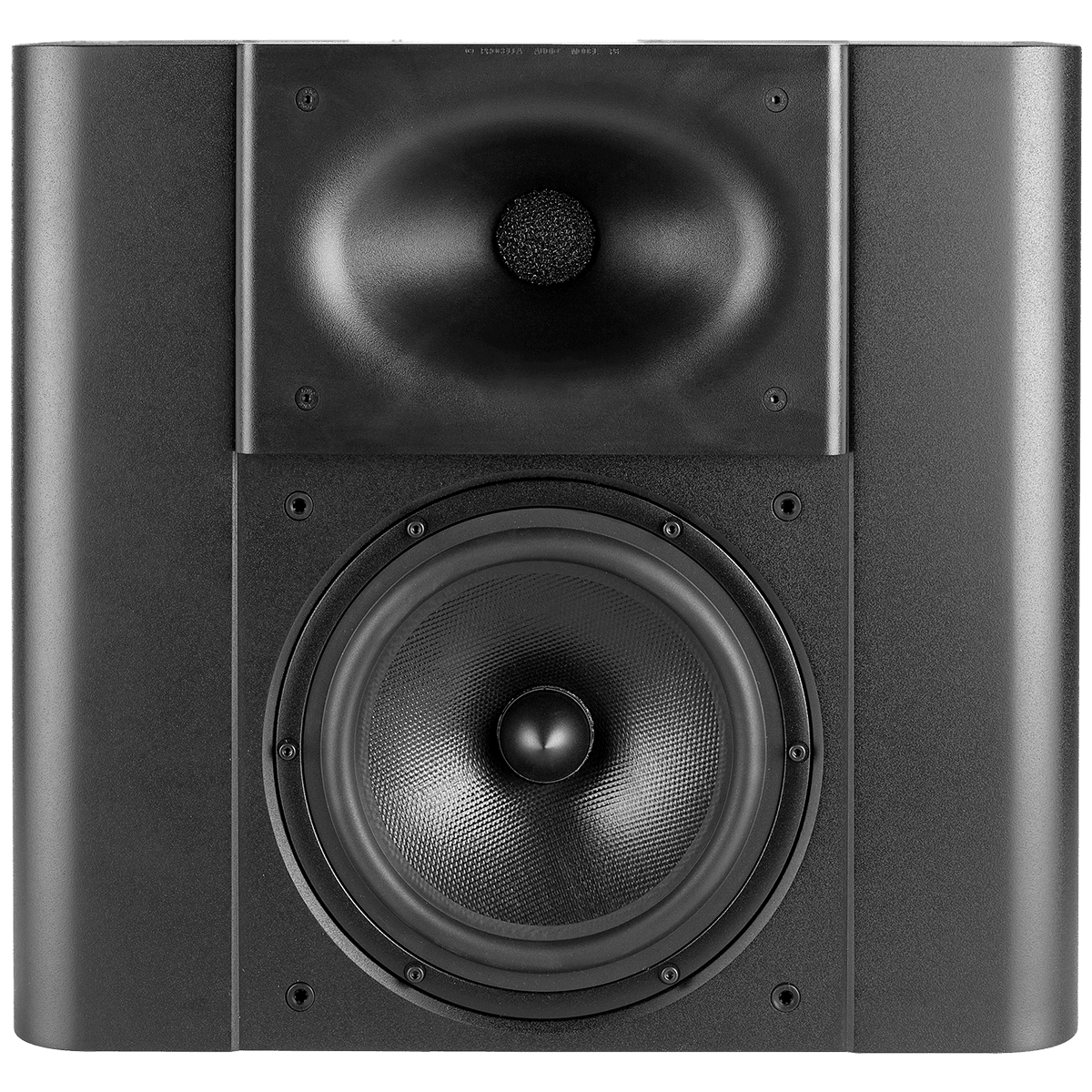
I have no doubts this gives excellent results, but WAF is close to zero.
Roundovers are effective and intereferences at the throat can be smothered in this way:

Perfect cabinet edges there, yet I'm sure that lip on both sides of the tweeter will mess up the diffraction
- Status
- Not open for further replies.
- Home
- Loudspeakers
- Multi-Way
- Does changing the enclosure shape from rectangle -> curved modify the sound?
